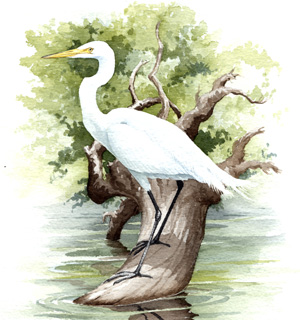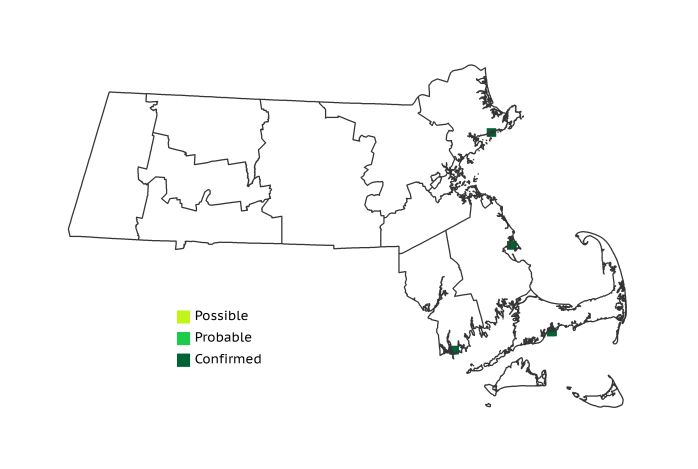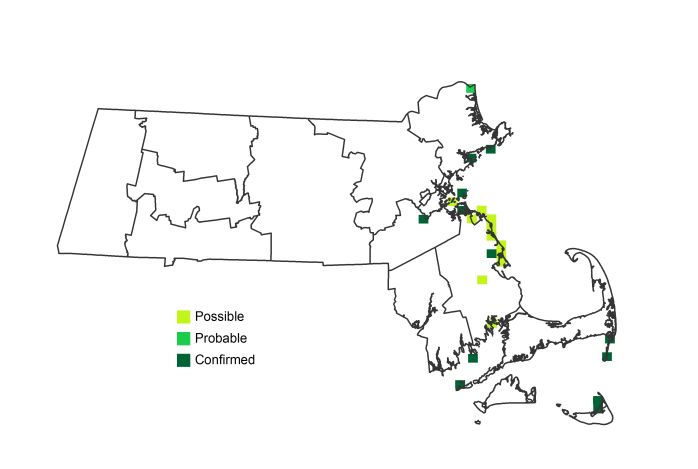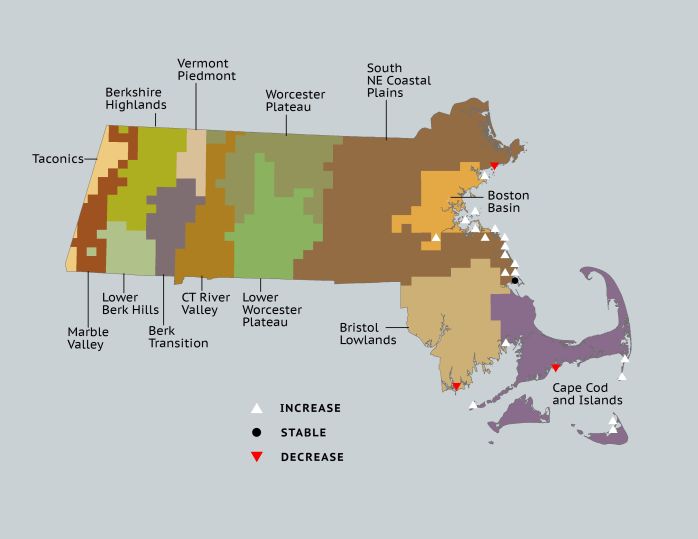Breeding Bird Atlases (BBA)
Find a Bird
Great Egret
Ardea alba

Local and strongly increasing
"And that's how I came / to the edge of the pond: / black and empty / except for a spindle / of bleached reeds / at the far shore / which, as I looked, / wrinkled suddenly / into three egrets - - - a shower / of white fire!” – Mary Oliver, “Egrets”
The elegant white plumes of the Great Egret likely evolved to maximize their effectiveness as markers of sexual fitness and desirability to other egrets. Unfortunately, these plumes had a similar effect on humans near the dawn of the twentieth century when the stately birds were slaughtered wholesale to be incorporated into women’s hats. After being nearly exterminated from North America in just a few short decades by plume hunters, Great Egrets have since recovered and are increasing as breeding birds in Massachusetts today.
Historic Status
Massachusetts ornithologists of the early 1800s took John James Audubon at his word when he said that “White Herons” visited Massachusetts from time to time. Typically not found north of New Jersey through the 1800s, however, individual birds occasionally did appear in Massachusetts as the century rolled forward. By 1878 Joel Asaph Allen had recorded sightings in Hudson, Ashland, Lynn, and Westford. By 1890 ten more occurrences had been documented (Howe & Allen 1901). It was legal protection at the beginning of the twentieth century, however, that finally saved the birds from the guns of the millinery trade and opened the door to a future for the species in Massachusetts. Edward Howe Forbush received 100 reports of sightings in 1921 alone, though he believed these may have included numerous misidentifications (Forbush 1925). By 1954, the first Great Egrets to breed in Massachusetts were found nesting in South Hanson (Petersen & Meservey 2003).
Atlas 1 Distribution
Considering the Great Egret’s history in the state, it seems almost miraculous that the species bred in Massachusetts at all during Atlas 1. With the depredations of humanity finally over, in the 1970s Great Egrets were marshaling for a return to the same territory from which they had once been nearly extirpated, this time apparently intending to breed in the Commonwealth. Large coastal heron rookeries at Clark’s Island in Plymouth Bay and House Island off the coast of Manchester each hosted breeding Great Egrets in the Coastal Plains ecoregion. Ram Island, the site of a heron colony off the southwestern coast of the Bristol/Narragansett Lowlands, also hosted breeding Great Egrets. The final block from Atlas 1 with a Confirmation came from Sampsons Island in the Cape and Islands region.
Atlas 2 Distribution and Change
Great Egrets continued their slow expansion in Massachusetts during the years between Atlas 1 and Atlas 2, with both greater distribution and an increase in the number of Confirmations recorded in Atlas 2. The expansion took place mostly in the Boston Basin and the Coastal Plains, but also on Nantucket and in Chatham, at the elbow of Cape Cod. Numerous Possible sightings should be taken with a grain of salt, since large herons and egrets can range far from their nests while foraging, sometimes giving even the most diligent atlas worker false hope.
Atlas 1 Map

Atlas 2 Map

Atlas Change Map

Ecoregion Data
Atlas 1 | Atlas 2 | Change | ||||||
Ecoregion | # Blocks | % Blocks | % of Range | # Blocks | % Blocks | % of Range | Change in # Blocks | Change in % Blocks |
Taconic Mountains | 0 | 0.0 | 0.0 | 0 | 0.0 | 0.0 | 0 | 0.0 |
Marble Valleys/Housatonic Valley | 0 | 0.0 | 0.0 | 0 | 0.0 | 0.0 | 0 | 0.0 |
Berkshire Highlands | 0 | 0.0 | 0.0 | 0 | 0.0 | 0.0 | 0 | 0.0 |
Lower Berkshire Hills | 0 | 0.0 | 0.0 | 0 | 0.0 | 0.0 | 0 | 0.0 |
Vermont Piedmont | 0 | 0.0 | 0.0 | 0 | 0.0 | 0.0 | 0 | 0.0 |
Berkshire Transition | 0 | 0.0 | 0.0 | 0 | 0.0 | 0.0 | 0 | 0.0 |
Connecticut River Valley | 0 | 0.0 | 0.0 | 0 | 0.0 | 0.0 | 0 | 0.0 |
Worcester Plateau | 0 | 0.0 | 0.0 | 0 | 0.0 | 0.0 | 0 | 0.0 |
Lower Worcester Plateau | 0 | 0.0 | 0.0 | 0 | 0.0 | 0.0 | 0 | 0.0 |
S. New England Coastal Plains and Hills | 2 | 0.7 | 50.0 | 11 | 3.9 | 45.8 | 7 | 3.1 |
Boston Basin | 0 | 0.0 | 0.0 | 5 | 8.9 | 20.8 | 5 | 9.1 |
Bristol and Narragansett Lowlands | 1 | 0.9 | 25.0 | 1 | 0.9 | 4.2 | -1 | -1.0 |
Cape Cod and Islands | 1 | 0.7 | 25.0 | 7 | 4.9 | 29.2 | 5 | 4.2 |
Statewide Total | 4 | 0.4 | 100.0 | 24 | 2.3 | 100.0 | 16 | 1.9 |
Notes
Surveys by the Massachusetts Natural Heritage & Endangered Species Program showed an increase in Great Egret breeding pairs from 69 to 228, in 1995 and 2008, respectively (Melvin 2010). The increasing number of birds was mostly due to the growth of three colonies: Kettle Island, Manchester; Sarah Island, Hingham; and Coskata-Coatue, Nantucket. Great Egrets were also found breeding at 6 other locations. Great Egrets show a significant increasing Breeding Bird Survey trend in the New England/mid-Atlantic region.



